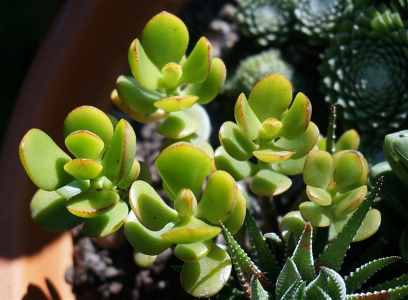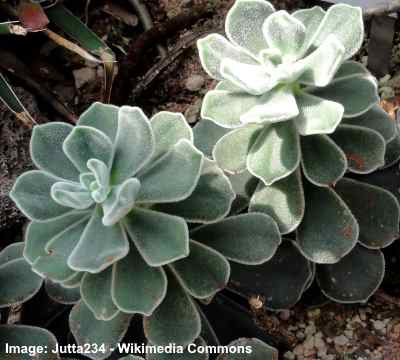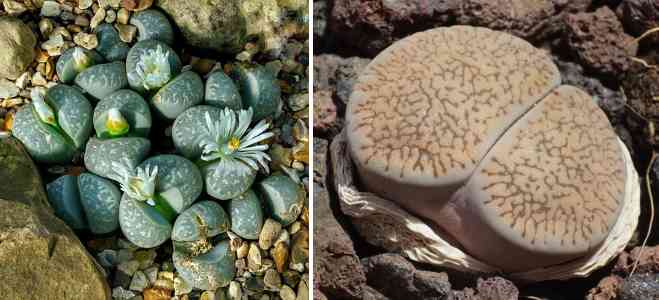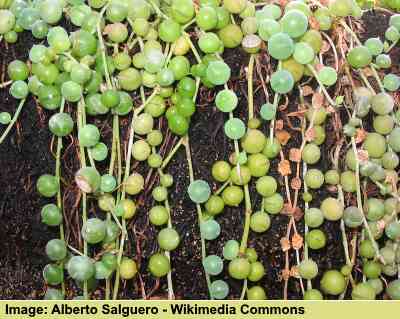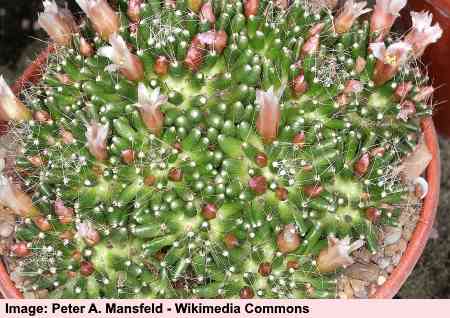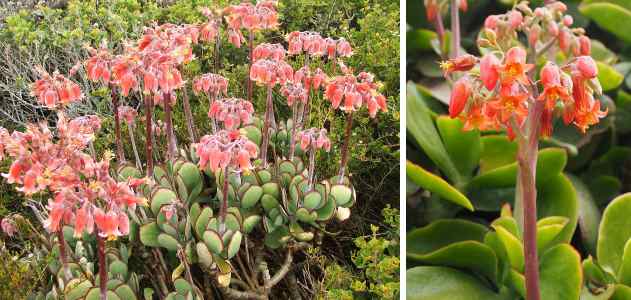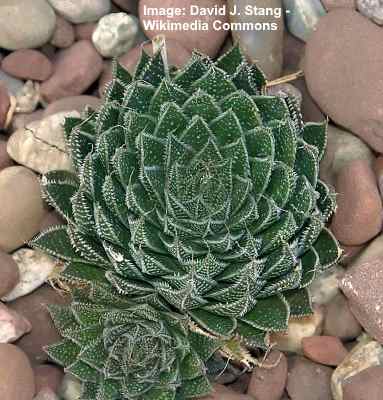71 Types of Succulents with Pictures and Names: An Identification Guide
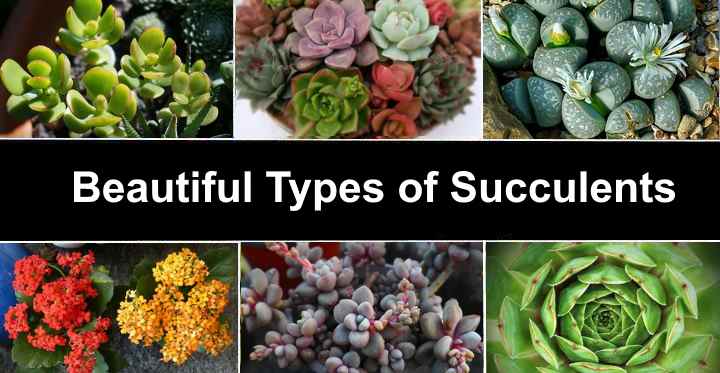
Are you searching for the perfect type of succulent for your garden or indoor space but feeling overwhelmed by the multitude of choices? In this comprehensive article, we present our top favorite succulent varieties, complete with pictures and names, to assist you in making an informed decision.
Succulents are a type of plant with thick fleshy leaves that grow well in warm dry conditions. All succulent species store water in their leaves, roots, or stems. Although most varieties of succulents have green leaves, some kinds have shades of red, blue, purple, pink and orange. Succulents are generally small compact plants that make great houseplants that require little maintenance.
There are an estimated 60 different plant families that contain varieties of succulents. Some well-known succulent genera include aloe and agave from the order Asparagales and echeverias, as well as jade plants and kalanchoes from the order Saxifragales.
It is important not to confuse succulents with cacti. Although the majority of cacti plants are classed as succulents, not all succulents are cacti.
How to Identify Succulents
The best way to identify succulents is by their leaf shape and growth habit. Of course, fleshy leaves are what classifies succulents apart from other plants.
Some succulent species have fleshy leaves that grow in a rosette shape, giving the plant a spiky look. Other types of succulents have spiky, oval, smooth, or strappy-shaped leaves. With some varieties of succulents, you may notice tiny ‘babies’ growing along the leaf edges.
With some succulent species, it can be difficult to tell them apart. For example, pictures of an echeveria and sempervivum may look remarkably similar. This is because both of these succulent genera are in the same order of fleshy-leaved plants.
Types of Succulents With Pictures and Names – Identification Guide
There are many different types of succulents and cactus that you can plant indoors or outdoors. This article contains a list of succulents and cactus with their picture and common name to help you identify them.
Indoor Succulents (With Pictures) – Identification Guide
Most succulents grow best in warm, dry climates. This means that some species of succulents are best suited for growing indoors.
Let’s look at some of the best succulent houseplants to help compliment your décor.
Aloe Vera (Aloe barbadensis)
Aloe vera is one of the most well-known types of succulents. Aloe vera is a fleshy green succulent plant that is characterized by its gel-filled leaves that have a soothing, healing nature. Aloe vera is just one of over 500 types of aloe plants in the genus Aloe.
Aloe vera is a tropical succulent species that can be identified by its long thick leaves that have slightly jaggy edges. Aloe vera doesn’t have a stem, but the fleshy leaves grow directly from the ground in a rosette-type shape.
Aloe vera plants also flower in the summertime. Long spikes up to 3 ft. (90 cm) tall grow up from the aloe plant and they have red or yellow tubular flowers drooping from the ends.
You can plant the aloe vera succulent in cactus potting soil or in a regular potting soil with extra perlite added to it.
Aloe vera can be grown outdoors in USDA zones 10 – 11 and in a protected area in the garden in zone 9.
Succulent identification: The aloe vera is a spiky succulent with easily identifiable bluish-green thick fleshy stems containing a gel-like substance. Look for tooth-like jaggy spikes along the pointed leaf margins.
Lace aloe identification: This aloe is identified by its white lacy patterns on the green pointed leaves. The succulent also has white small, raised bumps covering the fleshy leaves.
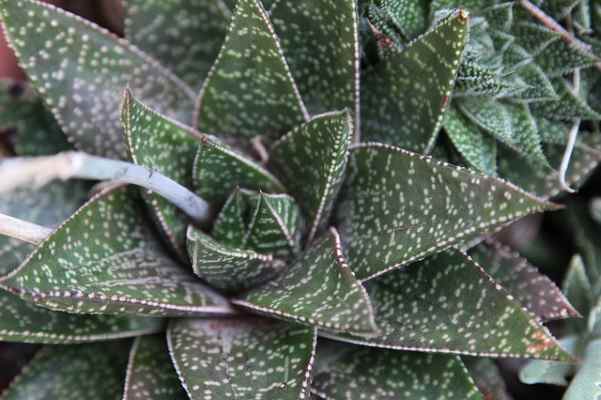
Lace aloe
Golden toothed aloe identification: The golden-toothed aloe plant has identifiable broad triangular leaves with spiky margins.
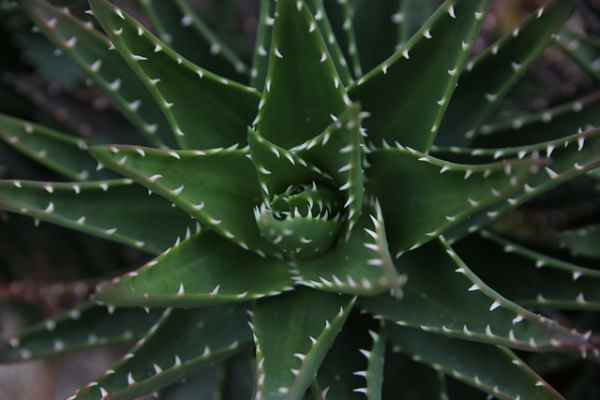
Golden toothed aloe
Burro’s Tail (Sedum morganianum)
‘Burro’s Tail’ is one of the best types of succulents to plant in hanging baskets due to its long trailing stems. Also known as ‘Donkey’s tail,’ this cool succulent has numerous small blue-green plump leaves that make the plant look like a tail. The long stems of the beautiful Burro’s Tail succulent can grow up to 2 ft. (60 cm) long.
Burro’s Tail is a species of perennial succulent that flowers. Usually, its small dainty pink or red flowers appear during the summer. As with most succulents, this succulent species requires full sunlight to keep the leaves a healthy color.
If you live in a warm climate, you can grow Burro’s tail outdoors in USDA zones 9 – 11.
Succulent identification: Burro’s tail is an easy succulent to identify due to its thick trailing stems covered in small, fleshy crescent-shaped leaves growing in a spiral pattern around the stem.
Flaming Katy (Kalanchoe blossfeldiana)

Kalanchoe succulent flowers come in a wide array of colors and include single flower (pink and red flowers in the picture) and double blooms (the yellow kalanchoe blossfeldiana ‘Calandiva’ cultivar)
The Flaming Katy is a cool flowering succulent variety that has shiny dark green leaves and beautiful flowers in the fall. Flowers on this succulent variety can be red, pink, orange, white, or yellow. The leaves of flaming Katy are ovate in shape and have a serrated edge. They form an interesting cup shape when the plant is mature.
A beautiful cultivar of Flaming Katy is called Calandiva plant (Kalanchoe blossfeldiana ‘Calandiva’). You can distinguish between Flaming Katy and Calandiva plants by their flowers: Flaming Katy has single-petaled flowers whereas Calandiva has showy flowers with double petals like a rose.
Although you can grow these types of Kalanchoe succulents outdoors, they are very sensitive to the cold. So, it is best to plant Kalanchoe in a succulent soil mix in a container and enjoy their beauty indoors.
You can grow kalanchoe plants outdoors if you live in USDA zones 10 and 11.
Succulent identification: The Kalanchoe blossfeldiana succulent has deep green leaves growing on short stems. This Kalanchoe plant has broad, rounded leaves with beautiful red, pink, orange, white, or yellow flowers.
Jade Plant (Crassula ovata)
Also called the Money Tree plant or Money Plant, the Jade Plant is an evergreen perennial succulent. Its thick shiny green leaves are oval or wedge-shaped and have delicate red edging on the tips. Identification of the Jade plant is by its thick trunk and multitude of leafy stems. Leaves can be up to 1.4” (4 cm) wide and 3.5” (9 cm) long.
To care for your jade plant succulent indoors, grow it in a room temperature of 65-75 °F (18-24 °C). In many cultures, jade plants have come to symbolize good luck and, therefore, this succulent is also named the Lucky Plant.
Jade plant is hardy in USDA zones 10 and 11.
Succulent identification: The jade plant succulent is identified by its rounded, leathery leaves that develop red blushing in full sun. The tree-like succulent has thick woody stems and may produce clusters of star-shaped pinkish flowers.
Echeveria

Echeveria succulents include many cultivars with beautiful colorful varieties
Echeveria is one of the largest genera of flowering succulents in the family Crassulaceae. Identification of the echeveria succulents is usually done by the compact rosette shape of its fleshy leaves.
Succulents in the echeveria genus are also some of the most colorful varieties. For example, the ‘Plush plant’ (Echeveria pulvinata) has lime green leaves with pink edges. The Echeveria laui is a blue type of succulent, and some species also have beautiful pink succulent leaves.
Some types of echeveria grow well outdoors in zones 9-11, but most people keep them in containers inside as a low-maintenance houseplant.
Succulent identification: Echeveria succulents have characteristic pointed leaves growing in the shape of a rose. The echeveria leaf shape helps identify these small succulent plants—some are rounded, others are triangular-shaped, and some have long spoon-shaped fleshy leaves.
Related: Echeveria Types and How to Care for Echeveria Succulents
Plush Plant (Echeveria pulvinata)
Native to Mexico, the Plush plant is a succulent that has ovate green leaves with pink tinges to the edges. Fine hairs on the succulent leaves give the plant a slightly fuzzy feel and appearance. The beautiful leaf coloring intensifies when it gets enough sun and it produces stunning orange flowers when it blooms.
Plush plant succulent is hardy in USDA zones 9-11.
Succulent identification: The plush plant echeveria is described as a fuzzy succulent with silvery-green leaves covered in white soft fine hairs.
Red Velvet Plush Plant (Echeveria pulvinata ‘Ruby’)

The red velvet plush plant has attractive green leaves with red margins
The red velvet plush plant is a green and red fuzzy succulent with lance-shaped fleshy leaves and small orange flowers. Unlike other species of Echeveria succulents, the red velvet plush plant leaves grow alternately on upright stems. The jade-green succulent leaves have thick reddish-pink fuzzy margins, giving the succulent an attractive appearance.
Other names for Echeveria pulvinata include Echeveria ruby, red velvet, and ruby slippers. The heat-loving succulent thrives in warm, sunny places and can withstand drought reasonably well.
Succulent identification: The red velvet plush plant succulent has pointed leaves characteristic of Echeveria plants. The bright red or pink edges on the thick leaves help tell the plant from other species of Echeveria.
Lithops
Some of the more unusually-shaped succulent species are those in the Lithops genus. These succulents are also named ‘living stones’ or ‘pebble plants’ due to their stony appearance. In fact, their name comes from Greek for ‘stone face.’
For many people, lithops are some of the coolest succulents you can grow indoors. The shape of lithops comes from 2 plump succulent leaves that are almost fused together. New leaves and flowers emerge from between the two leaves, causing them to split apart. The fat leaves can be in brown, gray, cream or green colors and have a bumpy texture. When growing in the wild, it can sometimes be difficult to tell lithops apart from stones.
When Lithops succulent flowers, it produces white or yellow flowers and this usually happens in the fall.
Lithops are hardy in USDA zones 10 and 11.
Succulent identification: Lithops are identified as small succulents that look like pebbles or stones. The pebble-like succulents have an identifiable split stem that divides when a new stem grows. However, the ‘living stones’ are hard to classify as they come in various colors and shapes.
Further reading: Living Stone Plant (Lithops): Care and Growing Guide.
Bear’s Paw Succulent (Cotyledon Ladismithiensis)
Looking at pictures of the Cotyledon Ladismithiensis, it is easy to see why it is also named ‘Bear’s Paw.’ The succulent leaves are covered in tiny hairs and the tips have teeth-like tips with delicate red edges, making the leaf resemble a paw.
When growing in the right conditions inside, the Bear’s Paw succulent can grow up to 3.2 ft. (1 m). Its thick fleshy leaves grow haphazardly on the stems, giving the succulent a bushy appearance.
As with growing most types of indoor succulents, you should grow Bear’s Paw succulent in a container just bigger than the root system. Deep watering once a week during the summer helps keep the plant healthy.
Bear’s paw succulent is hardy in USDA zones 9-11.
Succulent identification: The fuzzy succulent bear’s paw has cute furry rounded leaves that look like a tiny bear’s foot. Some types of bear’s paws have dark purple or red tips if they get plenty of sunlight.
String of Pearls (Senecio rowleyanus)
One of the prettiest hanging succulents is the String of Pearls. This creeping succulent species has pearl-like or pea-like green balls attached to thin stems. This ornamental succulent is from the family Asteraceae which means it is more closely related to daisies than cacti.
Another common name for the String of Pearls succulent is ‘string of beads.’ Its trailing stems grow up to 3 ft. (90 cm) long and have a number of small peas-shaped leaves on them.
Under the right indoor conditions, the ‘String of Pearls’ succulent flowers in the summer. The small white flowers are trumpet-shaped and classed as compound flowers – similar to other types of asters.
The string of pearls is pretty succulent and it’s one of the best plants for hanging baskets.
String of pearls succulent is hardy in USDA zones 9-12.
Succulent identification: String of pearls have identifiable round ball-like green leaves attached to dangling stems. The hanging succulent looks like green peas attached to dangling strings.
Pincushion Cactus (Mammillaria crinita)
The pincushion cactus is a type of succulent cactus. Due to its distinctive furry appearance, this cactus is a favorite with many people.
This spiky succulent is one of about 250 cacti in the Mammillaria family and is native to Mexico. One of the advantages of adding a pincushion cactus to your succulent garden is that it is quite short. It doesn’t grow taller than 6” (15 cm) and you will also get vibrant pink flowers when it blooms.
Pincushion cactus is hardy in USDA zones 9-11.
Succulent identification: The pincushion cactus is a fuzzy-looking green succulent covered with fine silvery-white hairs and light pink and white flowers.
Snake Plant (Sansevieria trifasciata)

The snake plant has ornamental green and yellow long leaves and requires little care – read about other types of snake plants (Sansevieria Varieties)
‘Snake plant’ is the common name for Sansevieria trifasciata and it belongs to the family Asparagaceae. The striking feature of the Sansevieria species is the long sword-like green leaves with yellow edging. This beautiful plant is actually a rosette-type succulent. The leaves grow tall and can reach up to 3 ft. (90 cm), with some being known to grow as tall as 6 ft. (2 m)!
One of the reasons to grow snake plant succulent indoors is that it grows well in poor conditions. This easy care succulent requires little maintenance and can provide attractive green and yellow colors to your home décor.
This succulent is also called ‘mother-in-law’s tongue,’ ‘St. George’s sword,’ and ‘viper’s browsing hemp.’
The snake plant is winter hardy to USDA zones 10-12.
Succulent identification: Snake plant succulents are easy to identify due to their long, pointed clumps of dark green and yellow fibrous leaves that grow upright.
Haworthia Fasciata “Zebra Plant”
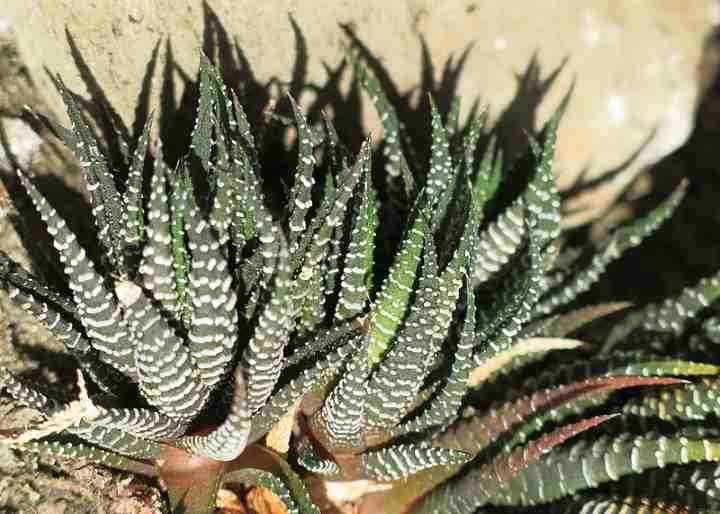
The Zebra plant is a small succulent with white markings that look like stripes
If you are looking for a small succulent with a striking appearance, then the Haworthia fasciata “zebra plant” is a great choice. These exotic succulents are native to South America.
The Zebra plant is a small succulent that only grows to about 4” (10 cm) tall. It has dark green triangular leaves with white stripes. Its thick fleshy leaves grow in a rosette form. This is a flowering succulent that may produce yellow flowers in late fall or early winter.
Zebra succulents are the perfect houseplant where space is limited.
Growing outdoors, Haworthiopsis fasciata “Zebra Plant” grows in USDA zones 9 to 11.
Succulent identification: The zebra plant is a thick-leaved succulent plant with a spiky appearance. The thick cylindrical pointed leaves are covered in raised white stripes and dots.
Haworthia cooperi – The Transparent Succulent
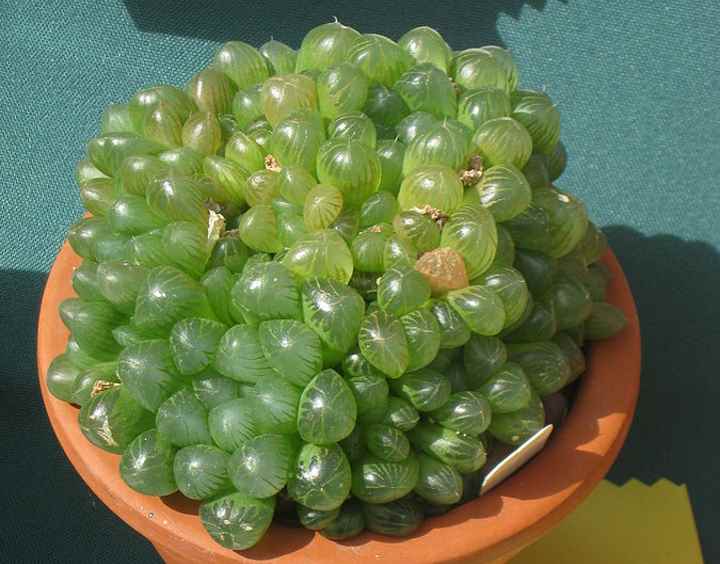
The Haworthia cooperi are slow-growing succulents with unusual fleshy translucent leaves
The Haworthia cooperi is a small rare succulent plant with fleshy translucent leaves. The “see-through” Haworthia cooperi succulent has shiny transparent leaves that grow in a rosette pattern in sandy soil.
The transparent Haworthia plant is very easy to grow at home. All it needs is some indirect light, warmth, and watering every so often.
Haworthia cooperi includes various cultivars with an interesting and unusual look. Depending on the Haworthia cooperi cultivar, the plump leaves can be triangular-shaped or globular.
Haworthia cooperi is hardy succulent in USDA zones 10 and 11.
Succulent identification: The Haworthia cooperi is an easily identifiable succulent due to its translucent ball-like or triangular, rounded light green leaves.
Hoya Kerrii (Lucky-Heart) Plant
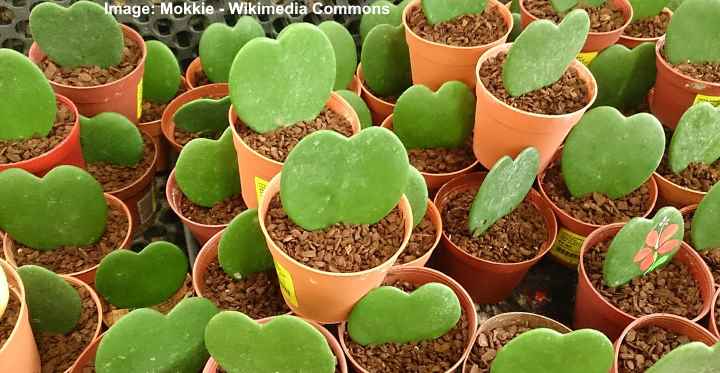
Hoya kerrii is a succulent that is also called sweetheart hoya or valentine hoya
The Hoya kerrii (sweetheart plant or lucky-heart plant) is a cool-looking type of succulent that is grown indoors. The heart shaped leaves of this type of succulent are the reason why it’s also named love heart plant.
The sweetheart succulent plant grows best in bright direct light and well-draining loose soil, with only occasional watering. Keep these unique and unusual indoor plants in a temperature range of 65°F to 80°F (18°C – 27°C) and medium humidity. Fertilize up to four times a year in the growing season.
Learn how to care for hoya kerrii (sweetheart plant / valentine hoya) and find other beautiful hoya varieties.
Hoya kerrii is winter hardy to USDA zone 11.
Succulent identification: The Hoya kerrii is easy to recognize due to its succulent leaves in a heart shape. Although the lucky-heart plant is a trailing or climbing plant, you will most commonly see the single leaves for sale in a pot.
Pig’s Ear (Cotyledon orbiculata)
The thick round leaves on this Cotyledon succulent give the plant its name of Pig’s Ears. The gray-green oval leaves can grow up to 5” (13 cm) long and have a distinct red line running around their edges.
The Cotyledon succulent plant can grow to about 4 ft. (1.3 m) tall, which looks stunning in a succulent garden. One of the best things with the Pig’s Ear succulent is when it blooms. Tall stalks produce a mass of dainty orange bell-shaped flowers.
The Pig’s Ears (Cotyledon) succulent is hardy in USDA zones 9-11.
Succulent identification: The pig’s ear succulent is identified by its dollar-shaped green leaves with red margins. The clumps of pale green leaves grow on woody stems, making the pig’s ear plant look like a small succulent tree.
Zwartkop (Aeonium arboreum ‘Zwartkop’)
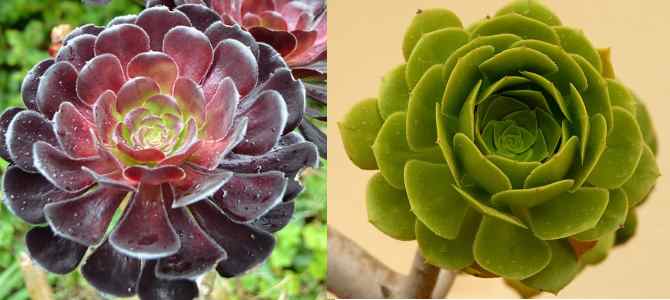
Aeonium Arboreum ‘Zwartkop’ (Black Rose Succulent) is a purple succulent whereas other common Aeonium Arboreum cultivars are green
One of the most striking succulents to grow in your garden is the Aeonium ‘Zwartkop’. Due to its dark-colored leaves and rosette shape, the Aeonium Zwartkop cultivar is also called the ‘black rose.’ What is even more stunning is when the dark purple succulent produces bright yellow flowers.
The common varieties of the subtropical Aeonium arboreum succulent have light lime-green leaves and grow as a small shrubby bush. The common species (Aeonium Arboreum) are also called ‘Irish rose’ and ‘treehouse leek.’
The Aeonium Zwartkop is hardy in USDA zones 9-11.
Succulent identification: The Zwartkop succulent has an easily recognizable large rose flower-like head on the end of woody stems. The characteristic of the Zwartkop plant is its dark purple, almost black leaves growing in a pinwheel shape.
Sunburst Succulent (Aeonium ‘Sunburst’)
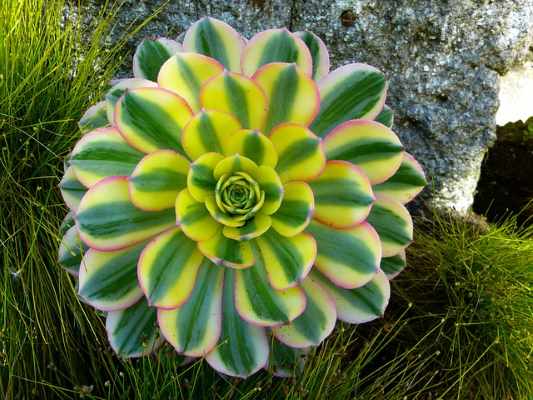
Aeonium ‘Sunburst’
The appropriately named ‘Sunburst’ succulent has green leaves with red or light pink edges fanning out in a circle from the center. This Aeonium succulent hybrid has branches with large rosettes that can measure up to 12″ (30 cm) in diameter.
The distinct pinwheel shape of Aeonium ‘Sunburst’ is representative of most succulents in the genus Aeonium.
The Aeonium ‘Sunburst’ succulent is hardy in USDA zones 9-11.
Discover other beautiful types of Aeonium succulents.
Succulent identification: The sunburst succulent is identified by its striped yellow and green leaves and bright pink margins. Growing in a large rosette shape, the sunburst succulent plant is one of the most colorful large succulents.
Mother of Thousands Plant (Bryophyllum daigremontianum or Kalanchoe daigremontiana)

Potted mother of thousands plants. Plants can grow up to 1.85 m tall (6 feet)
The mother of thousands plant (Bryophyllum daigremontianum or Kalanchoe daigremontiana) is an interestingly-shaped succulent plant that thrives indoors as a houseplant or outdoors in zones 9 – 11.
The unusual feature of the mother of thousands is the tiny plantlets that grow along the leaf margins. These plantlets grow roots, making the plant easy to propagate.
The mother of thousands is a highly invasive plant. The tiny plantlets grow vigorously, and the succulent can quickly overtake a garden. So, if you are growing the plant outdoors, it’s best to grow it in a container.
Succulent identification: The mother of thousands succulent has identifiable oblong leaves that are slightly folded along the midrib and have small plantlets growing along the margins.
Further reading: Mother of Thousands Plant Care.
Paddle Plant (Kalanchoe thyrsiflora or Kalanchoe luciae)
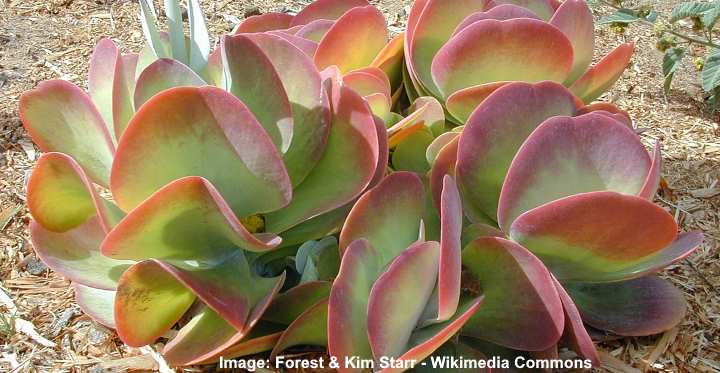
Kalanchoe thyrsiflora has green leaves with red margins that are enhanced when the plant is exposed to sun
Also named the flapjack succulent, the paddle plant has large spatulate leaves with red margins, characteristic of many types of succulents. The jade-green leaves can turn darker hues of red and purple when growing in cool temperatures. Paddle plant succulents grow up to 10” (25 cm) tall in pots.
The common name flapjack succulent comes from the way the flat, round leaves grow stacked like pancakes. Other names for the paddle plant include desert cabbage, white lady, and red pancakes.
Paddle plants only grow outside in USDA zones 10 through 12.
Succulent identification: Paddle plants have large, rounded waxy leaves that grow in a rosette pattern.
Further reading: Paddle Plant Succulent Care.
Woolly Senecio or Cocoon Plant (Caputia tomentosa)
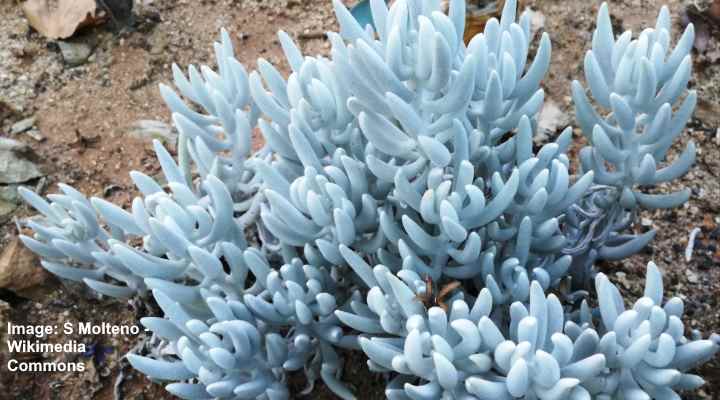
Woolly Senecio or Cocoon Plant (Caputia tomentosa)
The woolly senecio is a fuzzy succulent with small felted white cylindrical leaves growing in clumps from woody stems. The white-colored succulent has a striking appearance with its furry grayish-white leaves. Woolly senecio succulents grow between 4” – 10” (10 – 25 cm) tall.
The succulent also has the botanical name Senecio haworthii. The common names for the plant come from the fact that its leaves resemble small furry cocoons. Cocoon plants are not cold-hardy and need plenty of sunlight to thrive.
Succulent identification: The woolly senecio has easily identifiable fuzzy cocoon-shaped leaves growing in clusters up stems.
Pussy Ears (Kalanchoe tomentosa)
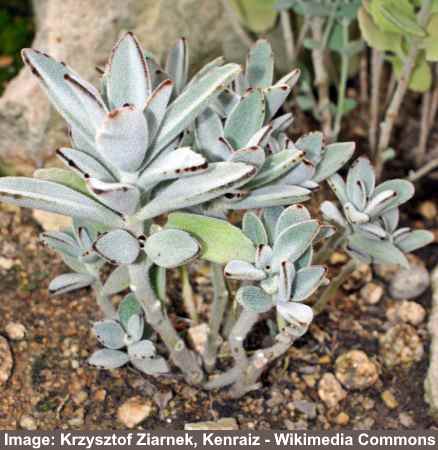
Pussy Ears (Kalanchoe tomentosa)
As the name implies, the pussy ears succulent is a fuzzy succulent with small, lightly folded leaves resembling a cat’s ears. The identifying feature of the pussy ears is the dark burgundy red rim around the leaf margins. Also called panda plants, pussy ears succulent cultivars typically have grayish or bluish-green leaves.
A pussy ears plant grows up to 1.5 ft. (0.45 m) tall, and the furry oval leaves grow on thick woody stems. The best place to grow a pussy ears plant is in a sunny spot on a south-facing windowsill. It can also be grown outdoors in USDA zones 9 – 11.
Succulent identification: Identify pussy ears by their oval grayish-green fuzzy leaves with dark red or brown tips around the rounded apex.
Moon Cactus
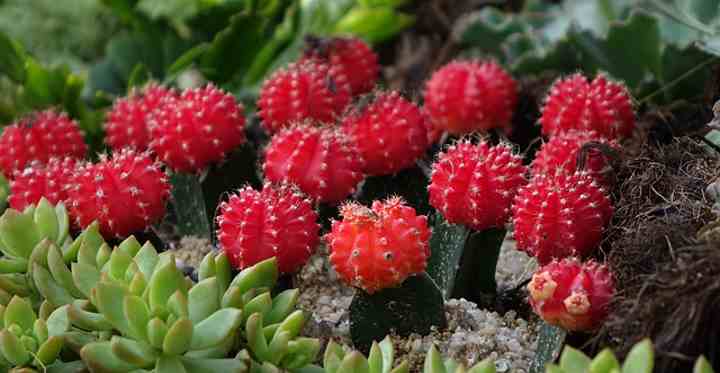
The colorful moon cactus gives a stunning look to any home
Moon cactus is an unusual colorful cactus with a colorful globular pink, orange, yellow, or red top, and dark green spiky stem. Types of moon cacti are developed by grafting a brightly-colored Gymnocalycium mihanovichii cactus on a regular cactus. These plants don’t produce chlorophyll, so grafting allows the colorful top to grow on any type of cactus.
Moon cacti are one of the most diverse types of succulents. You can find moon cacti with multi-colored ball-like tops. A trait of all moon cacti is the prominent ribs and small clusters of spines on the colorful top.
Grow a moon cactus in bright sunshine and water occasionally to help it thrive.
Because the bottom section is usually an upright cactus with a star shape on its cross-section, moon cacti also go by the name star-flower cactus.
Succulent identification: The most recognizable feature of a moon cactus is its brightly colored globular top sitting on a dark green base.
Further reading: Moon Cactus Care and Growing Guide.
Succulent Types for Outdoors (With Pictures) – Identification Guide
Succulents are great outdoor plants for planting in south-facing rock gardens in warm and dry climates. Some types of succulents such as agaves are also good for growing outdoors as they tend to be large plants.
If you live in cooler climates but still enjoy warm summers, then you can also grow succulents outside in containers and bring them indoors in the winter. Some succulents also are hardy enough to withstand harsh winters.
Most of the outdoor succulents mentioned here can also grow inside as interesting houseplants.
Agave
Agave is a genus of succulents in the family Asparagaceae and they can grow very large. Agave identification is by their large, thick triangular fleshy leaves. Some types of outdoor agaves are cold-hardy and can grow in USDA zones 5 – 10. Most agaves thrive in warmer climates in the Southern US, Mexico, and the Mediterranean.
One of the striking features of Agave succulents is when they flower. During this rare occurrence a long spike up to 21 ft. (7 m) emerges from the center of the rosette Agave plant.
Some agave species such as the ‘Golden Flowered Century Plant’ is rosette-shaped and has beautiful blue fleshy leaves. The ‘King of the Agaves’ is a stunning blue succulent with a spiky rosette shape. The ‘Artichoke Agave’ is a perennial succulent with triangular leaves in a large rosette shape.
Succulent identification: Agave succulent plants look like large aloe plants and have a clump of thick fleshy bluish-green leaves growing in a rosette shape.
Roseum Sedum (Sedum spurium ‘Roseum’)

In the pictures: Sedum spurium ‘Album’ succulent (left) and Sedum spurium ‘Purpurteppich’ succulent (right)
Roseum succulent plants are as beautiful indoors as they are growing outdoors. Their dainty light green succulent leaves have a pale pink tinge to their edges. The plant leaves are shaped in a rosette form and have slightly serrated edges. When in full sun, the color of the leaves intensifies and you should get beautiful light pink flowers when they bloom.
When growing outdoors in zones 4-10, this succulent grows vigorously and is great for full-sun ground cover. This beautiful plant also grows well in containers and makes for attractive hanging baskets.
Succulent identification: Roseum sedum succulents have green fleshy leaves that turn reddish-pink when growing in full sun. This ground-cover succulent plant also blooms with pink flowers when conditions are ideal.
Torch Plant (Aristaloe aristata)
The Torch plant is a succulent which is in the same tribe as aloe vera (Aloeae) and has a similar look. In the right conditions, the long fleshy triangular leaves in a rosette shape can grow to about 10 ft. (3 m) tall. The succulent green lance-shaped leaves are characterized by toothed edges. This gives the plant a bristly appearance and feel.
Torch plant is hardy to zones 8 – 10 and prefers the warmth. If you live in a warm climate and have space in your garden, then the Torch plant succulent can create an eye-catching feature.
Succulent identification: The torch plant succulent is with triangular green leaves with a rosette growth habit. The lanceolate succulent leaves have identifiable white-toothed margins and white bumps.
Hens and Chicks Succulent (Sempervivum tectorum)
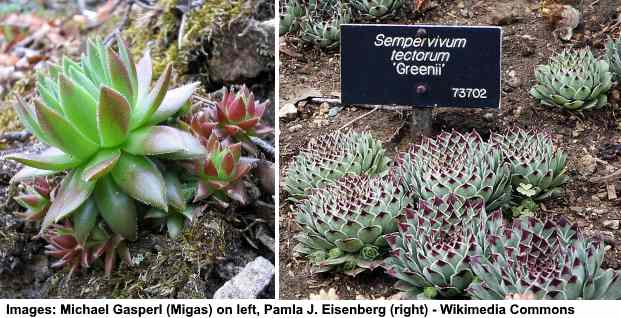
Hens and chicks are cold hardy succulents that can be used as ground-cover plants
One of the cutest types of succulent to grow in a rock garden or container is ‘Hens and Chicks’. Because of their hardiness and ability to survive all sorts of conditions, they are also called ‘live forever’ plants. Even in freezing cold climates, these pretty succulents stay green all year round.
Hens and Chicks is a cool succulent plant that grows in the shape of a beautiful rosette up to 4” (10 cm) across. The fleshy leaves can also be in a number of colors including blue, red, green with pink blushing, or green and purple tips.
Although these beautiful succulents only grow for about 3 years, the number of ‘chicks’ they produce means that they seem to live forever.
Succulent identification: Hens and chicks are small succulents with rounded or pointed leaves growing in a rosette pattern. There are many types of hens and chicks plants, each with beautiful green, red, blue, and pink colors and shaped like rose flowers.
Firestick Plant ‘sticks on fire’ (Euphorbia tirucalli ‘sticks on fire’)
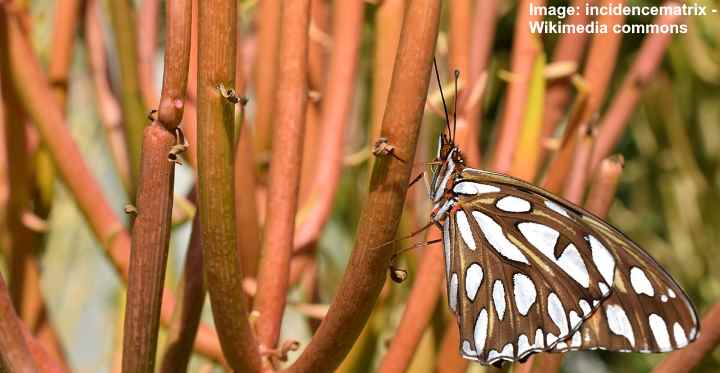
‘Sticks on fire’ plant contains toxic substance for humans and pets so you should handle it with extreme care
The firestick plant ‘sticks on fire’ (also called pencil cactus) is a type of succulent, not cactus, that has clumps of pencil-like stems exhibiting an orangey-red color that looks like it’s on fire.
Firestick plant is a large ornamental succulent that can decorate any garden or landscaped space with its stunning stem color. Because of its impressive growth and predominantly red colors, firestick plant bushes resemble sea coral.
The firestick plant is an easy succulent to grow and is hardy in USDA zones 10 – 12. The firestick succulent thrives in bright sunlight, warm temperatures, and low humidity.
It’s best to grow the firestick plant outdoors in warm climates, as this succulent contains white substance that’s toxic to dogs and cats, and can severely irritate the skin and eyes of humans.
Succulent identification: The firestick succulent has identifiable pencil-like stems that are shades of red or orange.
Candelabra Cactus (Euphorbia Trigona)
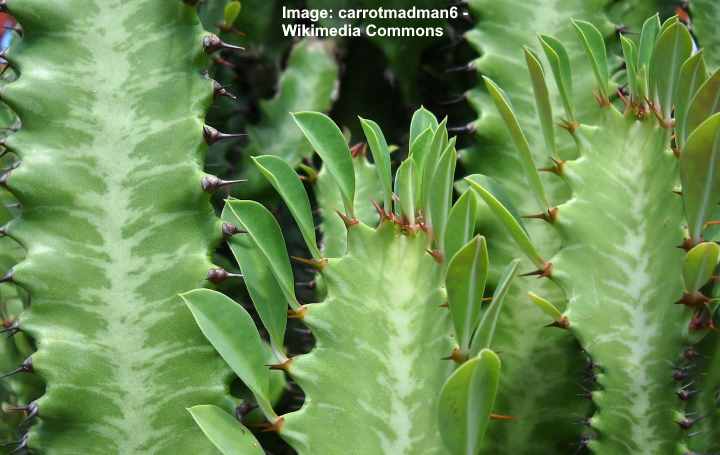
Euphorbia Trigona is an easy to grow low maintenance cactus-like succulent
The Candelabra cactus (Euphorbia trigona or Euphorbia cactus) is a type of succulent, not a true species of cactus. Also called the African milk tree, this plant is a tall-growing branching succulent that you can grow outdoors in a warm climate (USDA 10-11).
Euphorbia trigona succulent has a central stem with branches that grow upward. Along the ridges of the stems are thorns and small oval-shaped leaves. At maturity, the euphorbia plant reaches up to 6 ft. (1.8 m) in height.
The tall-growing Euphorbia succulent is easy to grow indoors as well. It thrives in a bright spot where it gets plenty of indirect sunlight. Read more on How to Care For African Milk Tree (Euphorbia Cactus / Candelabra Cactus).
Succulent identification: The candelabra cactus is a succulent with tall three-sided fleshy stems containing sharp spines. The succulent has offshoots from the main stem that turn upward, giving the tall succulent a classic cactus look.
Queen of the Night Cactus (Epiphyllum oxypetalum)

Queen of the night (Epiphyllum oxypetalum) is classified as an orchid cactus
Queen of the night cactus is a stunning succulent with flattened, broad, dangling leaves and huge white flowers that only bloom at night. The queen of the night is classed as an orchid cactus due to its epiphytic nature and showy orchid-like flowers. The cactus orchid’s climbing or pendulous leaves grow up to 20 ft. (6 m) long.
Although it doesn’t look like a typical succulent, the queen of the night has succulent fleshy leaves where it stores moisture. Queen of the night also goes by names such as lady of the night, night-blooming cereus, and Dutchman’s pipe cactus.
Grow queen of the night outdoors in USDA zones 10 to 12.
Succulent identification: You can identify a queen of the night orchid by its flattened succulent green leaf-like stems. Queen of the night blooms are large, white showy flowers 12” (30 cm) long and 8” (20 cm) wide.
Further reading: Queen of the Night Cactus: Plant Care and Growing Guide.
German Empress (Disocactus phyllanthoides)
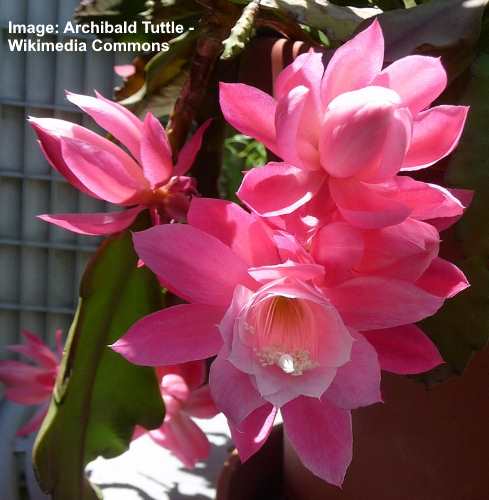
German Empress (Disocactus phyllanthoides)
The German empress is a flowering orchid cactus with green flat, leaf-like stems growing up to 3 ft. (1 m) long and showy pink flowers. Unlike the related queen of the night cactus, the German empress blooms during the daytime. However, growing conditions throughout the year should be ideal for the plant to bloom.
The German empress succulent is best grown outdoors in USDA zones 9 – 11.
Succulent identification: The best way to identify the German empress cactus is by its showy cup-shaped pink blooms that are 4” (10 cm) long and 3.5” (9 cm) wide.
Elephant Bush (Portulacaria afra)

Elephant bushes grown outdoors
Elephant bush is a shrub-like flowering succulent plant with small oval or obovate-shaped green leaves and clusters of star-shaped white or pink flowers. Growing in pots indoors, the colorful trailing stems look spectacular, dangling from hanging baskets. In USDA zone 10 and 11, the succulent grows as a shrub between 8 and 15 ft. (2.5 – 4.5 m) tall.
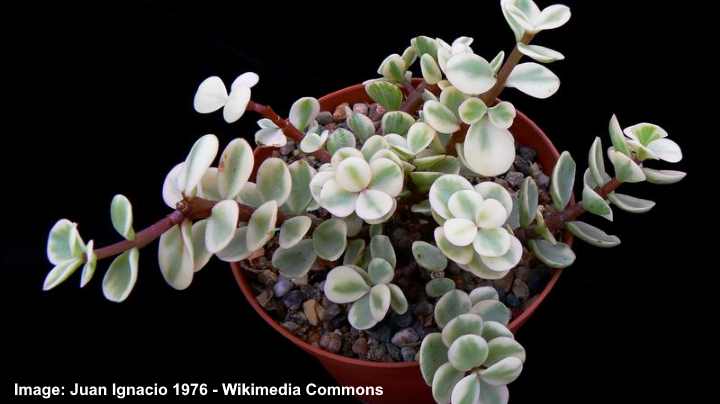
Portulacaria afra ‘Variegata’ grown indoors
The name of the succulent Elephant bush comes from the fact that elephants enjoy eating it. The succulent also goes by the names spekboom and porkbush. Because the bush-like plant looks like jade plants, it also has the name dwarf jade plant.
The Rainbow elephant bush (Portulacaria afra ‘Variegata’) is a variegated variety with green and creamy-white leaves.
Succulent identification: The elephant bush has identifiable reddish trailing stems covered in small rounded green leaves with the widest part at the apex and the narrowest part at the stem.
Types of Hanging Succulents (With Pictures) – Identification Guide
Many succulents grow fleshy or moisture-retaining leaves on dangling stems. Some hanging succulents such as Burro’s tail, Hindu rope, and queen of the night have thick stems that grow many feet long. These make eye-catching hanging basket plants. Other hanging succulents have thin, thread-like stems and unusually-shaped delicate leaves.
Here is a list of some delicate succulents that have stems that look like long dangling strings:
String of Bananas (Senecio radicans)—The thread-like stems have crescent-shaped leaves that look like bananas.

String of Bananas (Senecio radicans)
String of Dolphins (Senecio hippogriff)—The unusually succulent leaves look like dolphins jumping out of the water. Thus, the plant is also called the dolphin necklace.
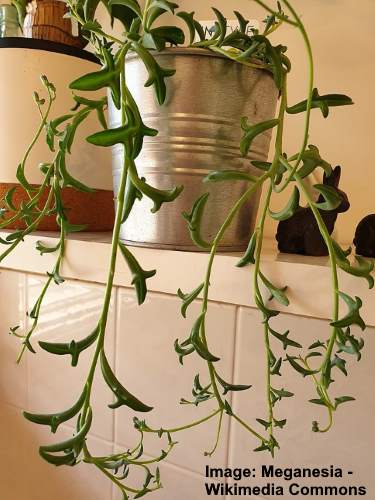
String of Dolphins (Senecio hippogriff)
String of Tears (Senecio herreianus)—The succulent trailing stems have masses of tear-shaped leaves that resemble a water droplet.

String of Tears (Senecio herreianus)
String of Nickels (Dischidia nummularia)—As the name suggests, the leafy foliage on the string-like stems consist of small oval leaves like nickels.

String of Nickels (Dischidia nummularia)
String of Hearts (Ceropegia woodii)—Beautiful heart-shaped leaves cascade on thin stems. The succulent leaves are grayish-green on the upper side and purple on the underside.

String of Hearts (Ceropegia woodii)
Further reading: Vining or Trailing Succulents for Hanging Baskets.
String of Buttons (Crassula perforata)
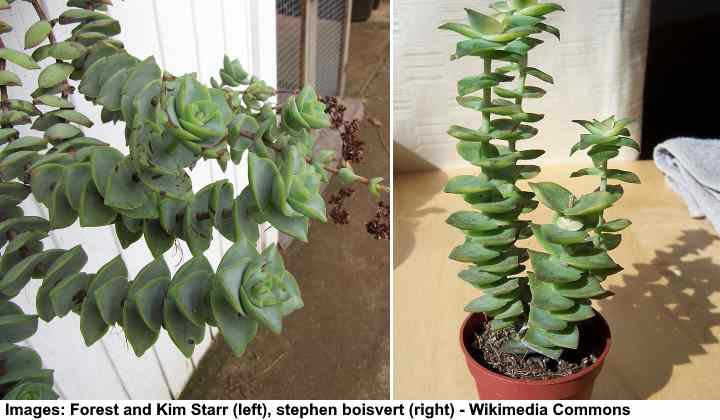
String of buttons young stems grow upright, but have trailing nature as they grow longer
The string of buttons is a shrub-like succulent with thick fleshy stems and leaves that look like they’re stacked on the stems. The succulent button-like leaves are jade-green with hints of pink and grow in opposite pairs along the stem. The sprawling succulent stems grow up to 2 ft. (0.6 m) tall and become pendulous over time.
The string of buttons has other names such as stacked crassula, pagoda plant, or necklace vine.
Succulent identification: The string of buttons has identifiable triangular leaves growing oppositely on succulent stems and look like the stem pierces through the middle of the stack of leaves.
Hindu Rope (Hoya carnosa ‘Compacta’)
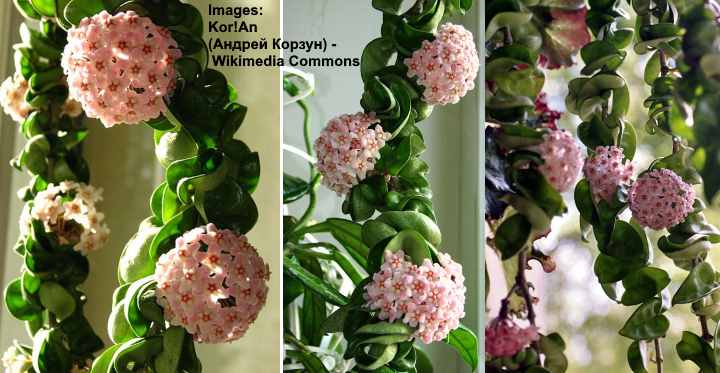
Hoya carnosa Compacta is also called ‘Krinkle Kurl’ or Hindu rope plant
The Hindu rope plant is a type of hoya wax plant with spectacular curled leaves growing on succulent vines with clusters of star-shaped pink porcelain flowers. The elongated oval or ovate leaves grow 1.2” to 2” (3 – 5 cm) wide and between 1.2 and 5” (3 and 13 cm) long. Hoyas produce clusters of sweetly-scented flowers in an umbrella shape.
Succulent identification: The Hindu rope has dark-green waxy leaves with a glossy surface. The Hoya carnosa ‘Compacta’ or Krinkle Kurl has twisted green leaves. The fragrant pink or white flowers have a fussy sheen and look like small stars.
Further reading: Hindu Rope Plant (Hoya Carnosa Compacta): Ultimate Care Guide.
Trailing Wax Plant (Hoya pachyclada)
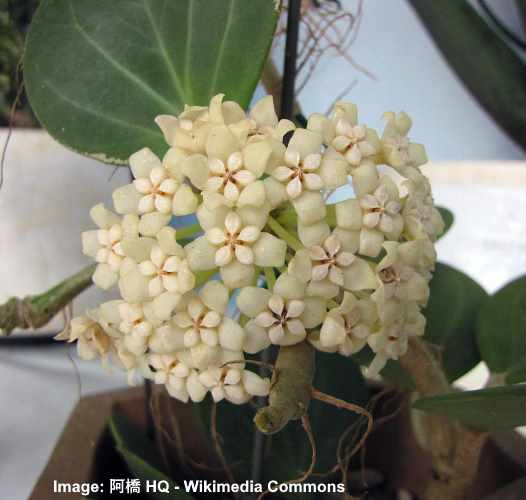
The trailing wax plant can grow outdoors in warm temperatures
The trailing wax plant has waxy oval leaves grown on trailing woody stems and clusters of scented white flowers. The hoya plant has compact growth and looks stunning growing in pots or hanging baskets. A feature of the hoya leaves is that they develop red edges on the round leaves.
The trailing wax plant flowers form a ball of white, star-shaped flowers. When blooming in spring, the hoya flowers give off a pleasant fragrance and may bloom numerous times in the season.
Succulent identification: Thick fleshy oval or round leaves growing compactly on woody stems and white flower clusters are the identifying features of the trailing wax plant.
Further reading: Hoya Plant Care: How to Grow Hoya Varieties (Wax Plant).
Calico Kitten (Crassula pellucida ‘Variegata’)
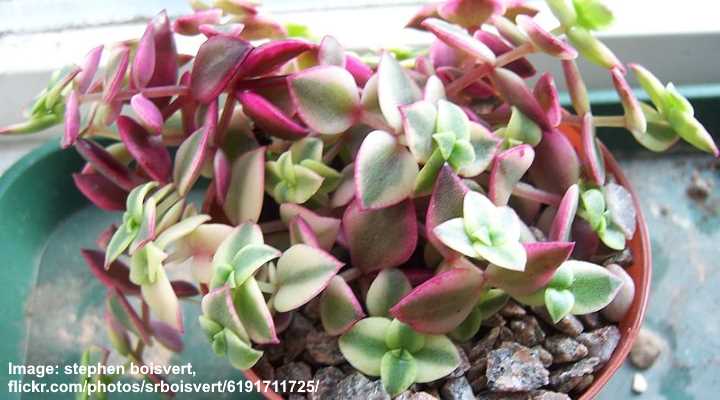
The colorful leaves of calico kitten add decorative touch to a hanging basket or as a ground cover
One of the prettiest succulents is the calico kitten with small creamy-white, green, and pink leaves. As a spreading succulent, the stems start to spill over the edge of its container. The leaves can have deep pink colors or just pale yellow with a light green center, depending on the growing conditions.
If you live in USDA zones 9 to 11, you can grow calico kitten plants in a rock garden as colorful ground cover for full sun. For most people, calico kitten plants are beautiful potted plants to grow on a sunny windowsill.
Succulent identification: Colorful calico kitten succulents are identified by their yellow-green elliptic leaves with rosy-red edges.
Lantern Flower (Ceropegia haygarthii)
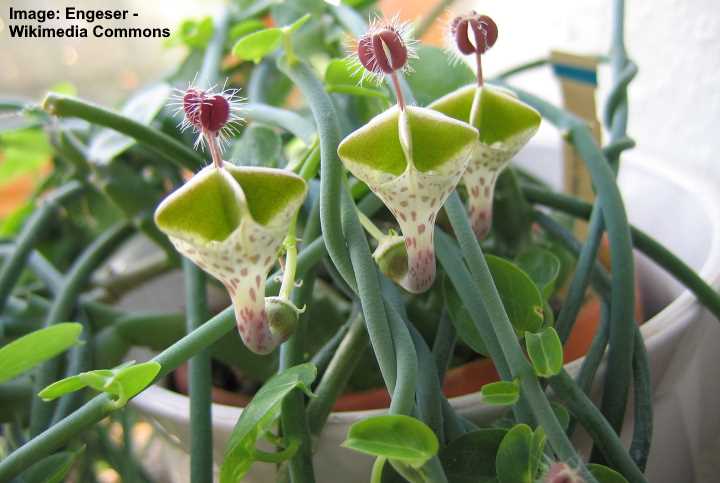
The unusual and unique flowers of Ceropegia haygarthii add interest to any hanging basket
The lantern flower plant is a compact hanging basket succulent with vines producing egg-shaped leaves and unusual succulent flowers. The lantern flowers are funnel-shaped with cream-colored petals covered with purple flecks. The unusual feature of the flowers is that they are fused at the tips and have protruding purple discs on a short stem.
Lantern flower succulent vining stems grow up to 10 ft. (3 m) long. The small green round leaves grow sparsely on the thick vines, and the creamy flowers grow 1.5” (4 cm) long and 1” (2.5 cm).
Succulent identification: The easiest way to identify the lantern flower succulent vine is by the tube-like flowers that curve upward and the five petals that fuse into a funnel-like flower.
Flowering Succulents (With Pictures) – Identification Guide
Here are beautiful types of flowering succulents to help brighten your garden.
Airplane Plant/Propeller Plant (Crassula perfoliata var. minor, formerly Crassula falcata)
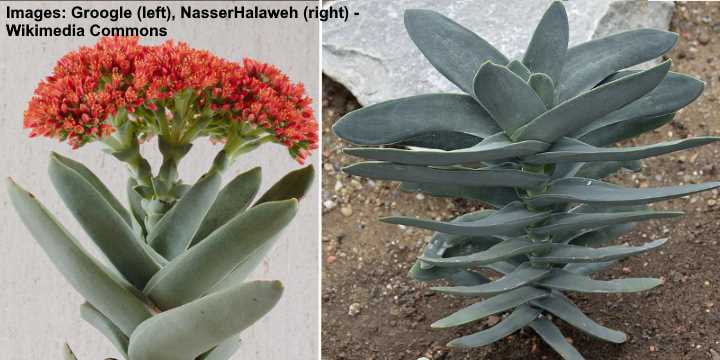
The airplane plant is a flowering succulent with green-gray leaves
The attractive airplane plant is a flowering succulent with gray-green leaves that grow in the shape of a propeller. The sickle-shaped fleshy leaves grow up to 4” (10 cm) long and 1” (2.5 cm) wide. The propeller plant grows up to 2 ft. (0.6 m) tall at its mature height.
One of the spectacular features of the airplane plant is its dense clusters of tiny bright red flowers. The showy scarlet red blooms emerge in mid-summer, and the airplane plant blooms for up to four weeks.
Succulent identification: The identifying features of the airplane plant are its grayish-green, slightly fuzzy leaves and dense clusters of red-blooming summer flowers.
Buttons on a String (Crassula Rupestris)
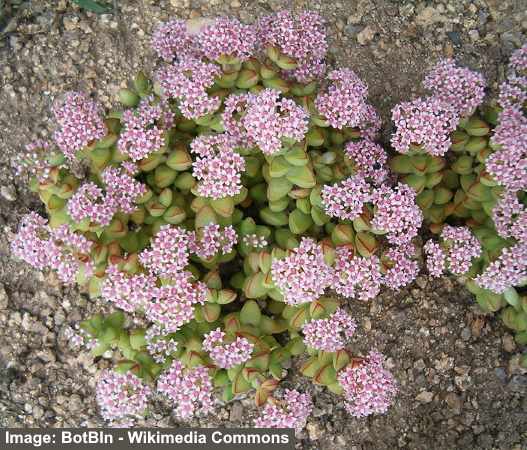
The attractive buttons on a string succulent with its pink flowers looks great in a rock garden or in hanging basket
Buttons on a string is a flowering succulent with small triangular-shaped leaves growing on upright branches. The leaves on this attractive succulent are grayish-green with maroon or pink margins. When growing in bright sunlight, the colors of the branching succulent become more vibrant. In some cases, the entire leaves turn pinkish-red.
Also called bead vine, necklace vine, or rosary vine, this colorful succulent grows 3 ft. (1 m) tall. Clusters of star-shaped flowers with light pink petals and a darker pink center almost cover the plant in the bloom season. Another attractive growth feature of the succulent is how the branches droop as they grow taller.
Succulent identification: The string of buttons is a delightful branching succulent with small pointed fleshy leaves that look as if they are strung together. Pale pink star-shaped flowers contrast nicely with leaves that turn red or yellow in summer.
Devil’s Backbone (Euphorbia tithymaloides)
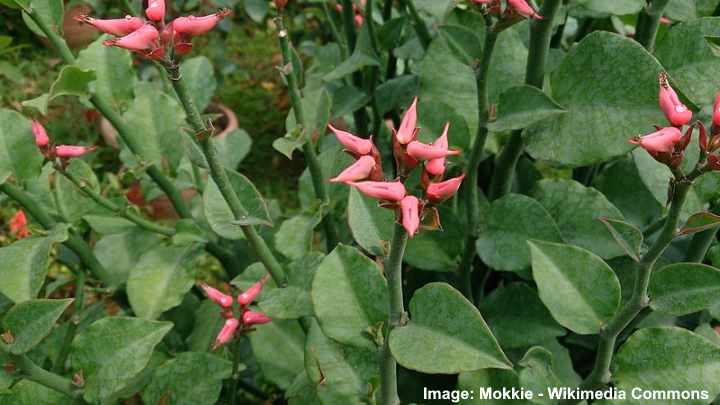
The red flowering devil’s backbone succulent grows well in warmer zones and full sun
Devil’s backbone is a perennial flowering succulent shrub with large, pointed ovate leaves and clusters of red tubular flowers. The smooth dark green leaves grow on stems that reach 6 to 8 ft. (1.8 – 2.4 m) tall. The cylindrical bird-shaped flower-like bracts grow at the end of tall stems.
Devil’s backbone has several additional common names, including redbird flower, slipper flower, fiddle flower, and zig-zag plant. It thrives in full sun in USDA zones 10 and 11.
Succulent identification: The identifying features of devil’s backbone are its pointed red flowers growing in terminal clusters, leaves with a tapering apex, and tiny ovoid seed pods.
Purple Spurge (Euphorbia amygdaloides ‘Purpurea’)

Purple spurge is a beautiful shade tolerant succulent with green and purple leaves and yellowish-green flowers
Also called wood spurge, purple spurge is a bushy evergreen perennial succulent with dark green oblong leaves growing on purple stems. In spring and early summer, lime-green flowers bloom at the ends of the erect leafy stems. The compact, shade-loving succulent grows 12” to 18” (30 – 45 cm) tall and wide.
Purple spurge is ideal for planting at the front of borders to add contrasting dark purple and bright green colors. It’s also suitable for ground cover in part shade, especially if your backyard has poor, sandy soil.
Succulent identification: Purple spurge gets its name from the deep purple stems and burgundy-purple foliage. These dark colors ideally set off the bright greenish-yellow spring-blooming flowers.
Baby Toes (Fenestraria rhopalophylla)

Baby toes succulents include various cultivars with white, yellow or orange flowers
Baby toes is a mat-forming succulent with only the tips of the cylindrical fleshy leaves visible above ground. This unusual geophyte succulent has columns of these club-shaped leaves, each with a transparent top. The eye-catching feature of baby toes succulent is the showy, colorful flowers with thin petals.
Fenestraria rhopalophylla: The succulent’s flowers are daisy-like with slender white to yellow petals surrounding a yellow center. The white and yellow succulent flowers grow singularly or in groups of three.
Fenestraria rhopalophylla subsp. Aurantiaca: This yellow-flowering succulent blooms with golden-yellow blossoms consisting of spindly petals growing at the end of thin stems.
Fenestraria rhopalophylla subsp. aurantiaca cv. ‘Fireworth’: Also called window plant, this baby toes succulent has large orange flowers with slender petals growing in a cup shape.
Bunny Succulent (Monilaria moniliformis)
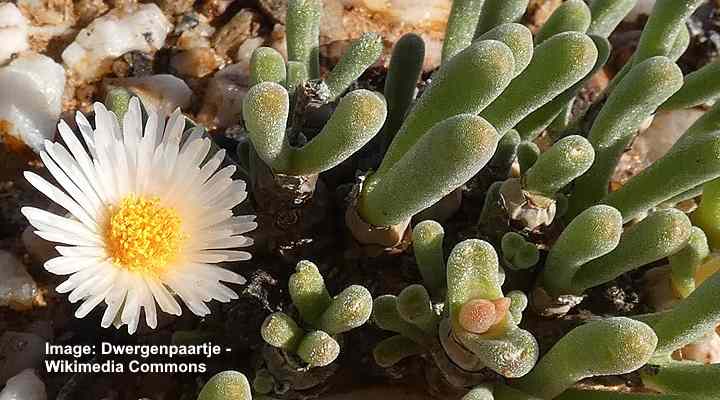
The flowering bunny succulent can be recognized by its cylindrical leaves that are fused in their base
Bunny succulents are a group of low-growing, clump-forming succulents with slender barrel-shaped fleshy leaves. This flowering plant blooms with attractive white and yellow flowers growing 1.6” (4 cm) in diameter. The unusual growth habit of the succulent is how the leaves disappear in the summer.
Bunny succulents grow up to 6” (15 cm) tall, and their leaves up to 1.2” (3 cm) in diameter. However, the cylindrical green succulent leaves only grow in winter. The common name of the plant comes from how some of its small leaves look like bunny ears.
Succulent identification: The identifying feature of bunny ear succulents is the cylindrical green leaves growing in pairs and fused at their base.
Other Types of Succulents
Jelly Bean Plant (Sedum rubrotinctum)
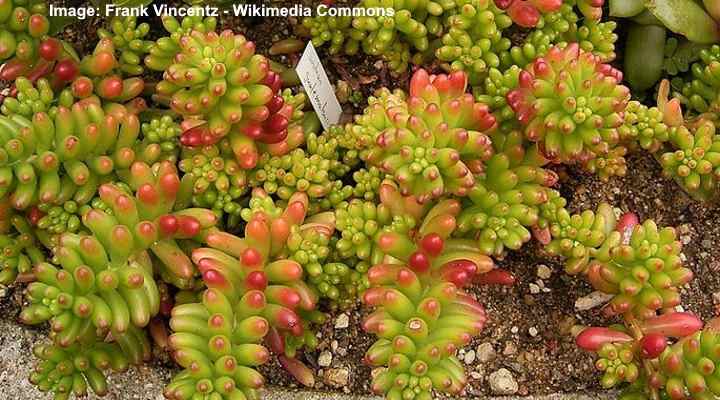
The attractive feature of the jelly bean plant is its green and red bean-shaped leaves
The jelly bean plant is a sprawling succulent with stems covered in green and red bean-like leaves. This ornamental succulent is prized for its colorful chubby foliage. The leaves look like jelly beans and turn deep red in full sun. The fleshy stems grow up to 8” (20 cm) tall, and the jelly bean leaves are 0.8” (2 cm) long.
Another attractive feature of the jelly bean plant is its bright yellow flowers that emerge in mid-spring.
The jelly bean plant is a cute, decorative succulent to grow in pots. In a landscape in USDA zones 9 through 11, you can grow the low-growing succulent as ground cover or brighten up a succulent garden. It’s also ideal for a xeric landscape.
Succulent identification: The identifying features of the jelly bean plant are its leaves resembling jelly beans that are green in winter and turn shades of orange and bright red in summer.
Ghost Plant (Graptopetalum paraguayense)

The ghost plant is a creeping succulent with green-gray rosette-shaped leaves
The ghost plant is an eye-catching succulent with large, thick, light gray to green leaves growing in a rosette flower shape. The spreading, creeping succulent has pointed leaves with a fleshy tip growing on stems up to 12” (30 cm) long. The large ornamental rosettes grow up to 4” (10 cm) wide.
The ghost plant is a sun-loving cold-hardy succulent in USDA zones 7 to 11. In spring, attractive sprays of yellow flowers appear. In addition, the fleshy leaves turn shades of dusty pink and pale yellow in hot, dry conditions.
Due to its trailing stems, the ghost plant is ideal for ground cover, beautifying a xeriscape, or growing in hanging baskets.
Succulent identification: The ghost plant’s identifying features are large, green-gray, or greenish-pink leafy rosettes growing on long, sprawling stems.
‘Cobweb Hens and Chicks’ (Sempervivum arachnoideum)
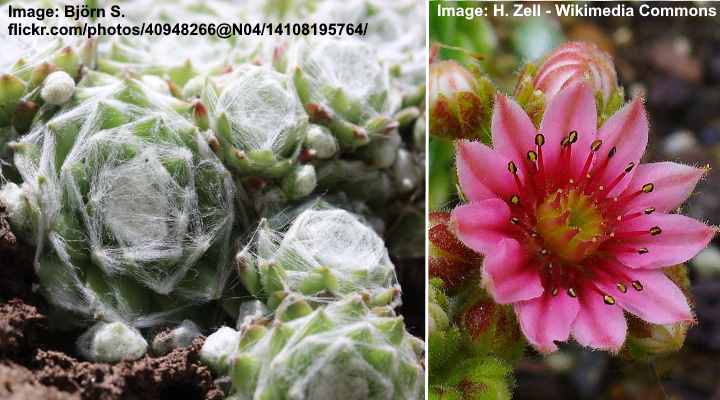
The unique identifying feature of the cobweb hens and chicks succulent is the white hairy covering on its dense rosettes
‘Cobweb Hens and Chicks’ is a low-growing, cluster-forming succulent with fleshy green foliage growing in tightly packed rosettes. The green rosettes are covered by a white, hairy, webbed covering resembling messy cobwebs. In summer, red-colored flowering stalks emerge from the plants and have star-shaped reddish-pink flowers.
An interesting feature of ‘Cobweb Hens and Chicks’ is that its foliage turns purple when exposed to direct sunlight. Being a type of Sempervivum, the succulent usually forms large spreading clumps and produce offsets and pups.
These succulents die after flowering. However, because they produce abundant offsets, the plant continues to grow and spread. This low-growing, spreading succulent grows 1” to 3” (2 – 7.5 cm) tall and up to 12” (30 cm) wide.
Succulent identification: The ‘Cobweb Hens and Chicks’ is easy to identify due to the cobweb-like growths covering the tight evergreen rosettes.
Sempervivum arachnoideum ‘Rubrum’: The outstanding, red-colored succulent has red fleshy leaves covered in soft white hairs and webbing. This feature gives the succulent a fuzzy appearance.
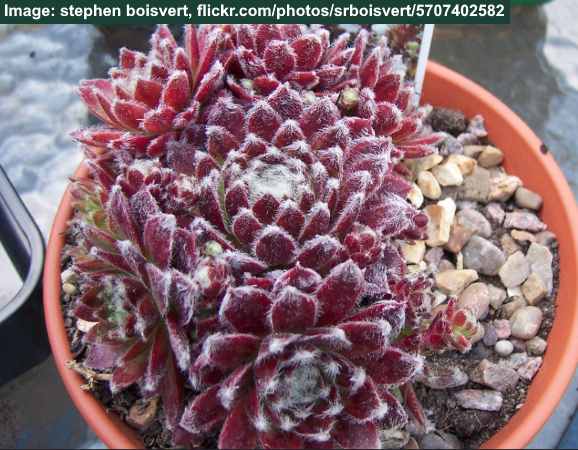
Sempervivum arachnoideum ‘Rubrum’
Purslane (Portulaca oleracea)
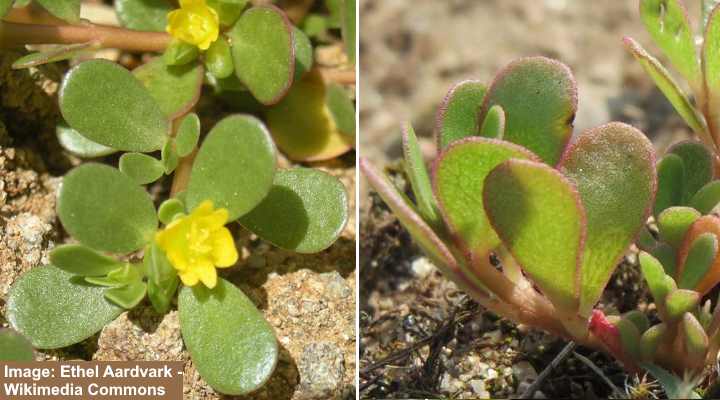
Purslane is a yellow flowering annual succulent but is tropical perennial in USDA zones 10–11
Purslane is an annual herbaceous plant with succulent spoon-shaped leaves and reddish stems. Yellow flowers bloom on the plant and feature four or five notched golden petals. Individual golden-yellow flowers measure 0.5” (1 cm) wide. Its low-growing prostrate habit forms a mat of succulent foliage in USDA zones 10 and 11.
Also called little hogweed or garden purslane, this trailing succulent has several ornamental features. The oblong, green edible leaves have a red tinge on the margins. In addition, yellow flowers bloom when moisture is sufficient. Due to its low growth, purslane is a perfect spreading succulent for full sun or partial shade ground cover.
Succulent identification: Purslane is identified by its glossy green, red-tinged oblong leaves, yellow flowers, and reddish stems.
Creeping Inchplant or Turtle Vine (Callisia repens)
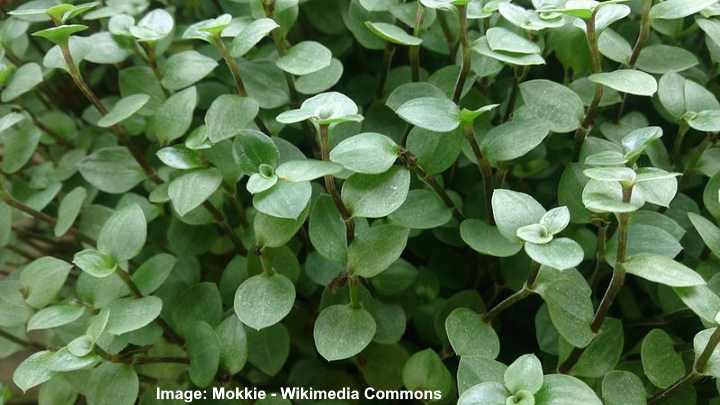
Creeping inchplant succulent is suitable as a ground cover plant for partly shaded areas or grown indoors in an indirect light
Creeping inchplant is a mat-forming, clumping succulent with small, fuzzy lanceolate leaves and small insignificant white flowers. A decorative feature of creeping inchplant foliage is its dark green color on the leaf’s upper side and rich purple below. This spreading succulent grows 4” (10 cm) tall and spreads up to 4 ft. (1.2 m) wide.
Also called turtle vine, this resilient succulent is easy to grow as ground cover in USDA zones 8 through 10. Due to its trailing leafy stems and scented white flowers, the succulent is ideal as a hanging basket plant indoors.
Succulent identification: Creeping inchplant is identified by small, pointed green and purple leaves covered in soft, fine hairs.
Little Pickles (Crassothonna capensis, formerly Othonna capensis)
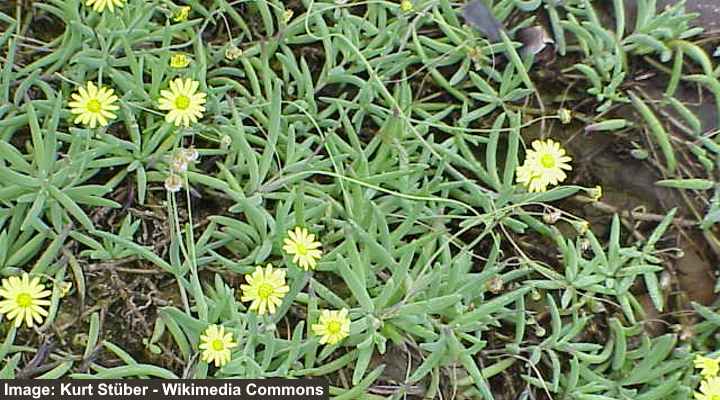
The trailing nature of the little pickles succulent makes it suitable for hanging baskets or as a ground cover
The little pickles plant is a trailing succulent with purple woody stems, slender finger-like leaves, and yellow daisy-like flowers. One of the ornamental features of this succulent is its unusual fleshy leaves resembling pickles that turn purplish-red in dry conditions. Little pickles stems grow up to 1 ft. (30 cm) long, making the plant a perfect succulent for growing in a hanging basket.
Also called ruby necklace, the succulent is suitable for growing outdoors in USDA zones 9 through 11. This fast-growing plant with its elongated bean-like leaves has attractive green, red, purple, and yellow colors. However, for the best colors, it’s best to grow the plant in shaded, cooler areas, protected from direct sunlight.
Succulent identification: Easy to identify, the little pickles succulent has fleshy succulent leaves that look like small green or red-tinged pickles dangling from trailing stems.
Silver Dollar Plant (Xerosicyos danguyi)
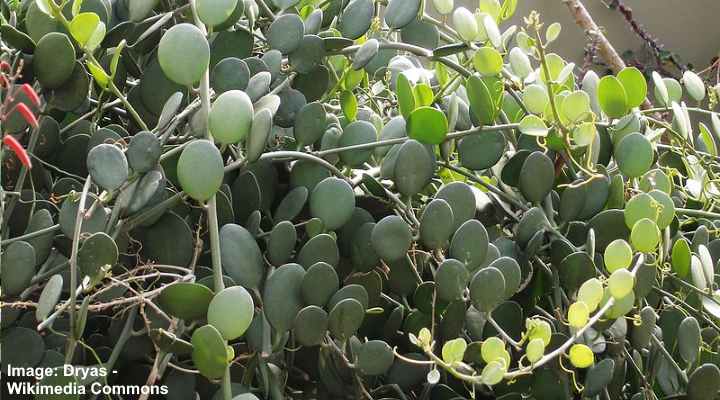
The silver dollar plant is a trailing succulent for full sun or partial shade with round green fleshy leaves
The silver dollar plant is a vining succulent with cylindrical stems, dark green round leaves, and yellow flowers. The common name for Xerosicyos danguyi comes from the leaves resembling the shape and size of a dollar coin about 1.6” (4 cm) long.
Another unusual feature is the plant’s tendrils that attach themselves to a trellis or chain-link fence.
The silver dollar plant is suitable for growing in full sun or partial shade in USDA zones 9 to 11. This scrambling, climbing succulent is ideal for covering a pergola or arbor. You can grow the succulent plant in a tall pot or hanging basket in cooler climates. Its trailing vines grow up to 20” (50 cm) long.
Succulent identification: The easily identifiable silver dollar succulent has thick, stiff, round gray-green leaves and yellowish-green flowers.
Starfish Plant (Orbea variegata, formerly Stapelia variegata)
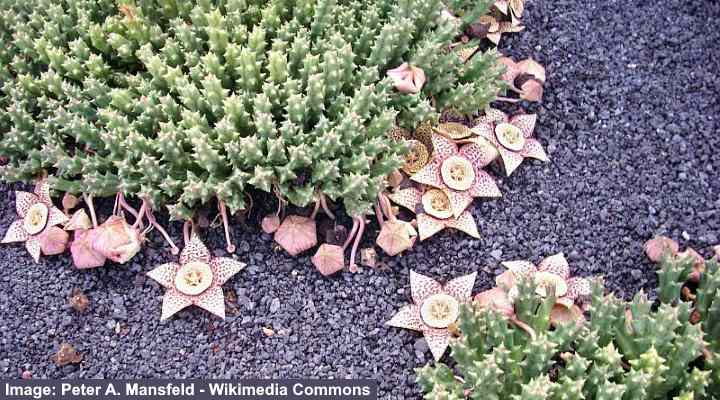
The starfish plant can be easily identified by its unusual star-shaped spotted flowers and unique looking spiky stems
The starfish plant is an unusual succulent with large flowers that look like a spotted starfish. The eye-catching flowers have five triangular leaves surrounding a round center. Each star-shaped yellowish-green and brown-speckled flower measures 3.2” (8 cm) across. Another spectacular feature is the four-angled toothed stems that are mottled green and purple-brown.
Growing in a warm landscape, the starfish plant grows as a clumping succulent. It creates a mound of spiny, upward-growing leaves, and the speckled flowers grow prostrate around the edges of the plant. The starfish plant grows 10” (25 cm) tall and up to 3 ft. (1 m) wide.
Succulent identification: The easiest way to identify the starfish plant is to observe the unusual star-shaped flowers with the speckled yellow-green leaves and brown dots giving them a pinkish appearance.
Turkish Stonecrop (Rosularia platyphylla)
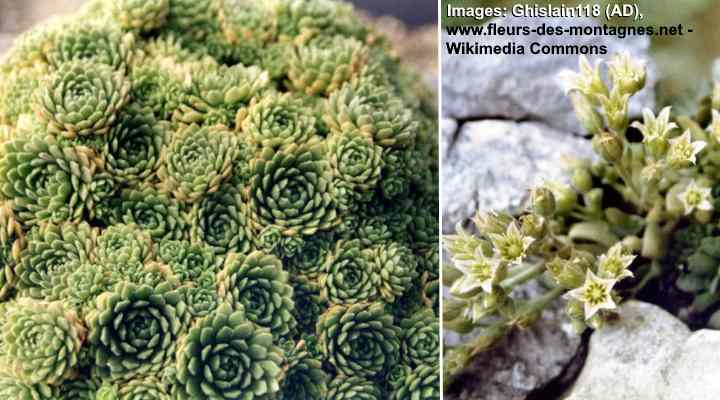
Turkish stonecrop is a cold hardy succulent identified by dense groups of rosette-shaped clumps
Turkish stonecrop is a mounding succulent that forms with densely growing groups of pale green rosettes. This low-growing sun-loving clump of succulent foliage grows up to 6” (15 cm) tall and spreads up to 12” (30 cm) wide. The cold-hardy succulent is suitable for dry landscapes in USDA zones 5 to 10.
Turkish stonecrop has growth similar to ‘Hens and Chicks.’ Its flower-like rosette foliage is formed from spoon-shaped, slightly hairy leaves. In addition, small clusters of white tubular flowers emerge in summer.
Succulent identification: Turkish stonecrop is easy to identify due to its dense clumps of leaves growing in a rosette shape.
Graptoveria
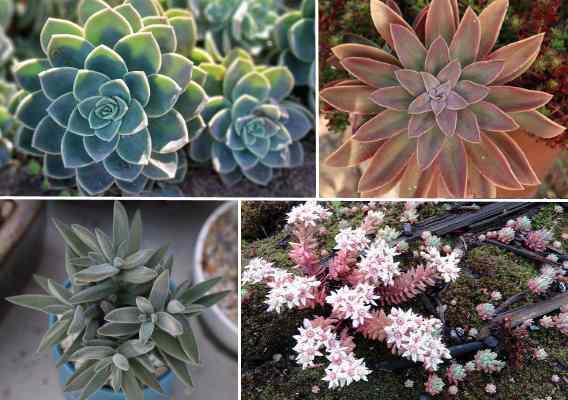
Graptoveria succulents are hybrid between echeveria and graptopetalum and include various colorful types
Graptoveria is a small succulent plant with attractive fleshy rosettes growing on short stems. Some of these succulent species have short, triangular, blue-green leaves. Other Graptoveria succulents have elongated pointed leaves that are greenish-brown, pale pink, or deep red.
Crassula x graptoveria: This graptoveria cultivar has bluish-green rosettes growing on woody stems. The attractive feature of this succulent is several pale whitish-pink leaves contrasting with the blue-green foliage.
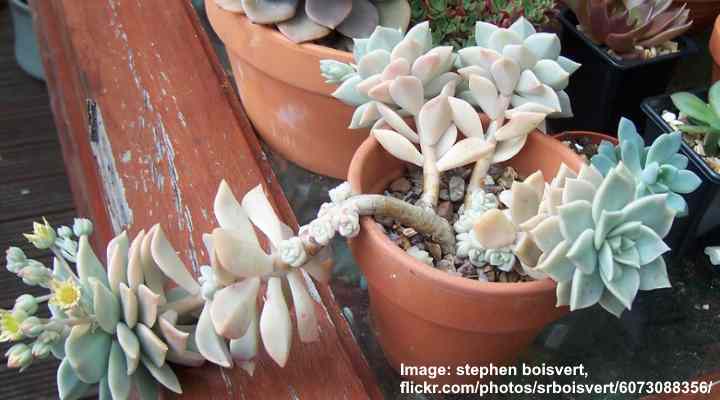
Crassula x graptoveria
Graptoveria ‘Fred Ives’: This succulent has pale purple leaves growing in a loose rosette pattern.
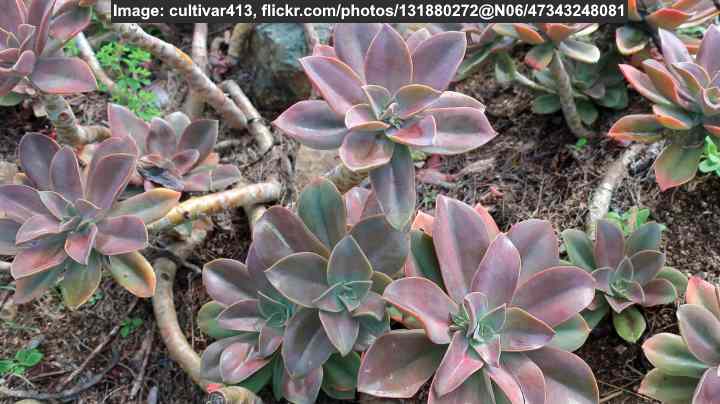
Graptoveria ‘Fred Ives’
Beads Lampranthus (Braunsia maximiliani)

Beads lampranthus is a low growing succulent identified by its gray-green fused leaves and pink flowers
Beads lampranthus is a compact, low-spreading succulent with large rose-colored flowers. The trailing stems produce gray-green leaves that are fused one-third of their length. In late winter, the succulent blooms with several bright pink flowers measuring 1” (2.5 cm) in diameter.
Beads lampranthus is a pink-flowering succulent suitable for growing outdoors in USDA zones 9 through 11. It is relatively slow growing and can survive intense heat and some frost. However, it needs protection from direct sunlight in the hottest months.
Succulent identification: Bean lampranthus is identified by its grayish-green boat-shaped leaves and pink and yellow daisy-like flowers.
Chinese Jade (Sinocrassula yunnanensis)
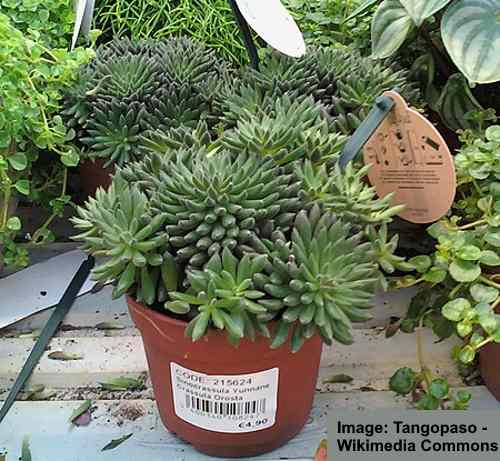
Chinese jade succulent is identified by its clumps of rosette-shaped fleshy leaves
Chinese jade is a small succulent with half-round, flattened leaves growing in small clumps. The succulent leaves grow in a rosette pattern and can reach 4” (10 cm) tall and 1.5” (4 cm) in diameter. An unusual feature of this succulent is how the dark bluish-green leaves turn deep purple to black in full sun.
Succulent identification: The identifying features of Chinese Jade are its tiny fuzzy dark green leaves that turn black and small white flowers that bloom in summer and fall.
Cocoon Plant (Pachyveria haagei)
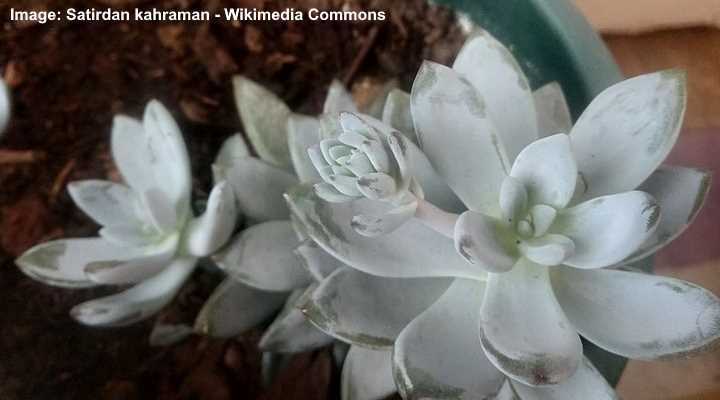
The cocoon plant has silvery green rosette-shaped foliage and is a a slow-growing succulent
The cocoon plant is a slow-growing succulent with gray-green leaves growing in a rosette pattern. This easy-to-grow succulent can grow up to 12” (30 cm) tall. However, it will take many years to reach that height. Like many succulents in the Crassulaceae family, this color of the succulent intensifies in bright sunlight.
Succulent identification: The cocoon plant has plump grayish-green succulent leaves growing in an open rosette pattern.
Mangave
Mangave succulents are found in hot and dry areas, and were created from hybridizing plants in the genus Agave and the former genus Manfreda.
The drought-tolerant mangaves look like agave plants with stiff colorful and patterned succulent leaves, but they lack the spines of agave plants. Mangave plants usually grow up to 24″ (60 cm) high, although some cultivars grow larger. Mangaves also produce flowers in the summer.
Mangaves can grow in full sun but prefer shaded areas. They can also tolerate freezing temperatures of up to -6 °C (21 °F).
Here are some attractive cultivars of mangaves:
Mangave ‘Kaleidoscope’: This spectacular succulent has long, arching, lance-shaped dark green leaves with vibrantly colored bright red margins.
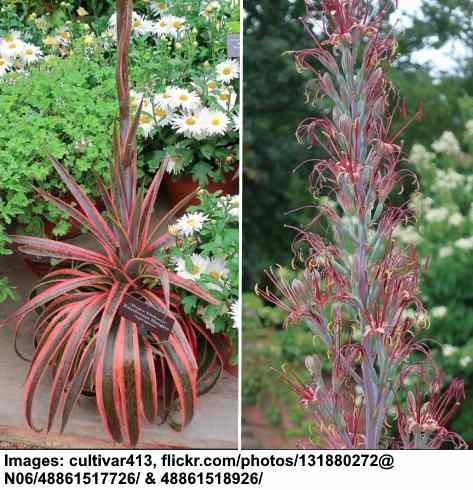
Mangave ‘Kaleidoscope’
Mangave ‘Mission to Mars’ and ‘Inca Warrior’: These brown-red perennial evergreen succulents have thick lance-shaped burgundy-red leaves with faint green speckles. The leaf edges curl upward, revealing cinnamon spines.
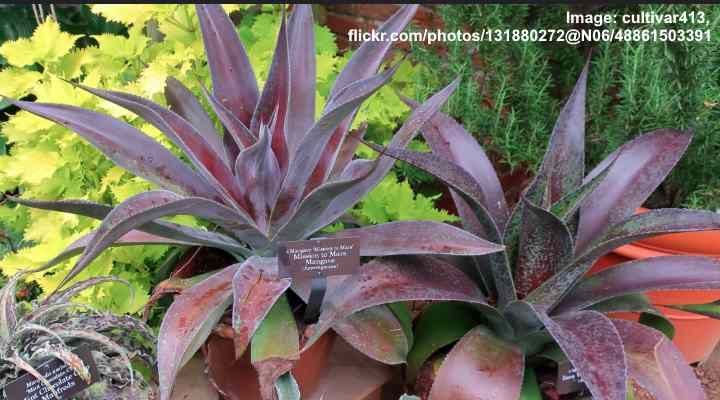
Mangave ‘Mission to Mars’ and ‘Inca Warrior’
Mangave Agave x Manfreda: This succulent Mangave cultivar has a densely growing rosette form with long, pointed green arching leaves and toothed margins.
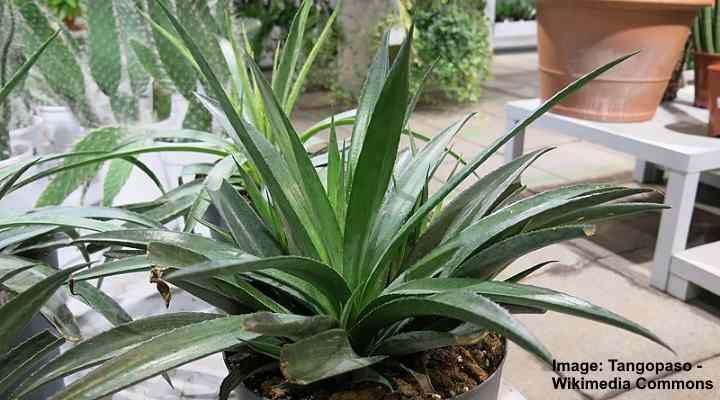
Mangave Agave x Manfreda
Manfreda undulata ‘Cherry Chocolate Chip’: An outstanding succulent with slender lanceolate leaves. The narrow leaves with their upturned wavy margins are mottled dark green and brown with brilliant cherry red margins.

Manfreda undulata ‘Cherry Chocolate Chip’
How to Care for Succulents
Succulents are generally easy-to-care-for houseplants. Their fascinating shapes, textures, and colors look beautiful in any room. Succulents are generally kept as small indoor plants, and you can care for a few of them easily without any bother.
Most types of succulents require similar care to help them keep their color and grow properly. You should place your succulent in bright sunlight and rotate them every so often so all parts of the plant get the sun.
Succulents also should be placed in well-drained soil to prevent root rot. Usually, regular cactus potting soil is perfect for growing succulents at home. You should water your succulents when the top 1” (2.5 cm) of soil is dry. To make sure your succulents get enough water, pour in enough water until it runs out the drainage holes.
With indoor succulents, you also need to wipe the dust off the leaves with a damp cloth. This helps to encourage growth and keep your indoor succulent houseplants healthy.
Read the ultimate guide to caring for succulents and keeping them alive.
Related articles:
- How to Care for Succulents
- Types of Cacti for Indoors and Outdoors
- The Best Potting Soil Mix for Succulent Plants



